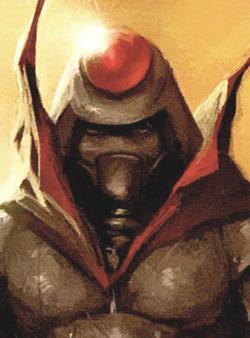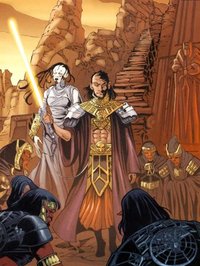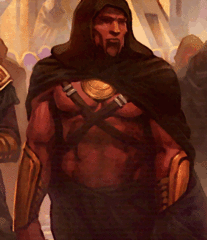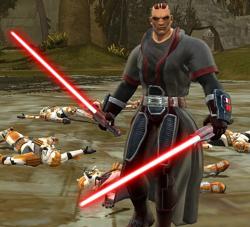Sith Legends
1. Introduction
The most popular of the Dark Side Orders in the Dark Jedi Brotherhood is the Sith Order. Though derided as mindless fighter jockeys by their Krath and Obelisk brethren, the Sith Order has the longest history, far predating the Brotherhood itself, and counts among its ranks many of the leaders of our organization. This course should serve as an introduction to the history of the Sith before the Brotherhood all the way through to its formal organization into a distinct Order, as well as give you an understanding of the paths a modern Sith might embark upon.
2. History of the Sith
2.1 Pre-Brotherhood History
King Adas, Sith’ari

The origins of the Sith Order begin far in the prehistory of the Republic, when a species indigenous to Korriban known as the Sith banded together approximately 28,000 years before the Battle of Yavin (BBY). Though the Sith had previously competed against each other in rival tribes, they became united after a warlord and Sith magician by the name of Adas brought the tribes together through many conflicts. During this time, many of his people believed he would live forever and gave him the title of Sith’ari, which meant Overlord. The period of time during his rule became known as the Reign of the Axe.
During Adas’ reign, the planet was discovered by the Rakatan Infinite Empire. During this time, the Rakata shared much of their technology with the Sith in an attempt to bring them into their Empire. When that failed, they attempted an invasion. At the advanced age of 300 years, King Adas lead his people against the Rakata and pushed the Infinite Empire back across several planets, though at the cost of his own life. However, this allowed the Sith access to the greater galaxy and emboldened them to expand their own Empire among the stars.
Dark Exiles

In 6,900 BBY, after their defeat at the Battle of Corbos, which finally put an end to a period of strife known as the Hundred-Year Darkness, a group of exiled Dark Jedi led by Ajunta Pall discovered the Sith species still residing on Korriban. These Dark Jedi were able to use their deep knowledge of the Force to impress the primitive (yet still powerfully Force-sensitive) Sith, and the two groups - Dark Jedi and Sith - became so closely intertwined that the term “Sith” lost its racial connotation. Going forward, the term became commonly used for all Dark Jedi, even those not of Sith blood. A new ruling class of these intermixed Sith and Dark Jedi arose: the Sith Lords. The preeminent Sith Lord styled himself the Dark Lord of the Sith, and a new Sith Empire arose to terrorize the galaxy.
Golden Age of the Sith
For over a thousand years, the Sith - both those of “pure” Sith ancestry as well as the hybrid Sith/Dark Jedi - expanded their Empire, taking planet after planet. However, this expansion was limited to areas mostly out of the eye of the Republic, and so the two sides rarely caught each other’s attention, let alone found themselves in conflict. It was in this environment one of the most important leaders of the Sith, Marka Ragnos, took the mantle of Dark Lord. Under his leadership, the Empire entered into what historians now call the Golden Age of the Sith.

As goes all things, however, Ragnos’ Golden Age wouldn’t last forever. Upon his death, two Sith Lords competing to take his place - Ludo Kressh and Naga Sadow - tore the Sith Empire apart. Their actions, in fact, spawned the Great Hyperspace War, where the two forces of the Sith clashed with each other as much if not more than with the Republic. Their infighting so weakened the Sith Empire that the Republic was eventually able to emerge victorious, and the Sith were shattered.
Great Galactic War and Emperor Vitiate
However, the Sith were not finished. The Sith Emperor Vitiate had taken a group of followers to the distant planet Dromund Kaas, where he and his newly-reformed Dark Council toiled in obscurity to build their own Sith Empire and get vengeance against the Jedi. After creating their own society, with every facet controlled by the Emperor and his Council, and with the Imperial Navy trained to the utmost, the Emperor launched an invasion of the Republic in 3,681 BBY that became known as the Great Galactic War.
Though the Republic had its share of victories, the overall outcome was most certainly a victory for the Emperor by the year 3,653 BBY with the signing of the Treaty of Coruscant. This peace could hardly be called such, as a Cold War began immediately between the Republic and the Empire. Eleven years later, the Galactic War broke out between the two feuding sides. Though the full history of this Galactic War has been lost to the ages, it should be clear by the fact that the Republic survived for another 3,000 years that the Sith failed to destroy them.
Brotherhood of Darkness and Darth Bane
In 1,010 BBY, the Sith once again came to power following Jedi Master-turned-Sith Lord Skere Kaan. Kaan destroyed several of the Sith Lords that helped rule the Sith Empire, taking their assets and forming his own Brotherhood. Kaan had grown tired of the wars between the Sith and the Republic and turned against the Jedi Order, forming his Dark Army and Sith Council of Lords.
As the Brotherhood of Darkness brought more and more worlds under its banner, the Jedi Master Lord Hoth rallied the Jedi and Republic forces to try and stop the spread of this new Sith Empire. The war came to a conclusion on the world of Ruusan, where Kaan destroyed many of the Jedi forces and the entirety of the Brotherhood of Darkness' lords through the use of a Force thought bomb.
However, Kaan was mislead into using the devastating ability by the young Sith Lord Darth Bane. Bane had long decided that the downfall of the Sith had been that they were too public with their power and would always be destroyed by the Republic and the Jedi unless a change was made. Bane then instituted the Rule of Two. There would only exist one master, and one apprentice. One to have power and one to want the power. He further decreed that the Sith would work to destroy the Republic and the Jedi slowly over millennia as opposed to outright combat. This worked well over the next 1,000 years, and soon the Sith were thought to be extinct, even by the wisest Master Jedi.
Clone Wars and Resurgence of the Sith
The Sith as a species was a long forgotten legend by 32 BBY. While the organization was long thought to have disappeared from the galaxy by many powerful Jedi, such as Master Mace Windu and Grand Master Yoda. It was not until this year that Master Qui-Gon Jinn and his apprentice Obi-Wan Kenobi engaged a Sith Lord by the name of Maul on the planet Naboo that the Jedi Council began to think that the Sith had been hiding themselves and their machinations through the Force.
In 22 BBY, with the start of the Clone Wars, the Jedi once again found themselves on the battlefield against several Sith. They were fooled into believing that Count Dooku, a Jedi Master turned Sith, was the Master behind the war. In 19 BBY, Supreme Chancellor Palpatine of Naboo confided in Jedi Knight Anakin Skywalker of his identity as Darth Sidious, the master behind the war and the issues with the Galactic Senate. Skywalker alerted the Jedi Council, who attempted to arrest Palpatine.

After slaying several Jedi Masters, Palpatine feigned weakness at the feet of Master Mace Windu while Skywalker watched. Before Windu could deliver the final blow, Skywalker turned on the Jedi and disarmed Windu, allowing Darth Sidious to finish the Jedi Master off. With Skywalker turned and renamed as Darth Vader, Sidious initiated Order 66, which ordered all clone troopers to kill their Jedi commanders. With Darth Vader’s destruction of the Jedi Temple, the Sith had destroyed all but a tiny remnant of the Jedi. This would remain the case until the resurgence of the Jedi at the hands of Vader’s children, and even more on the planet New Tython.
2.2 Dark Brotherhood History

The history of the Sith within the Dark Jedi Brotherhood begins with a pureblood member of the Sith species known as Okemi, a Sith Lord who lived approximately 5,100 BBY. He was an influential member of Marka Ragnos’ Sith Empire who unsuccessfully rose up against Ragnos and was banished for his trouble. He fled Ziost, the capital of the Sith Empire at the time, and eventually landed upon Antei, where he set himself up as a God-King.
However, serving as God-King was not enough for Okemi and his two closest confidantes and advisers - the Krath Sorceress Tiamat and an assassin named Ferran. Tiamat urged Okemi to perform a ritual similar to that of her former Master, Aleema Keto, to use the Force to achieve immortality. Okemi and Tiamat began a ritual to harness the power of Ante, the sun of the Antei system, theorizing that this would be enough to carry out the ritual. Ferran, who had been opposed to the plan from the beginning, decided to put his dissent into action and plunged his sword in Tiamat’s heart. This stopped the ritual and killed both Ferran and Tiamat, but it also caused what we now called the Obscuration: it turned Ante into a black dwarf star and devastated the rest of the Antei system in the process. Okemi’s body perished in the blowback from the interrupted ritual, as well, but unlike Ferran and Tiamat, his spirit still resided in what became known as the Star Chamber.
Besides serving as a historical warning to members of the Sith Order (and others) of the folly of overreaching, Okemi also plays a vital role in the Tripartite Path, one of the foundations of the Dark Jedi Brotherhood. The founders of the ancient Star Chamber on Antei, which counsels and enacts the will of the Grand Master, were a Warlord (Okemi), a Scholar (Tiamat, who figures heavily in the history of the Krath), and an Assassin (Ferran, creator of the Obelisk). As one of the parts of this triumvirate, Okemi urged his followers to attain power through positions of authority within the Brotherhood and to constantly seek to subjugate the Obelisk and Krath Orders as he ruled over Ferran and Tiamat.
True to this dictate, many of the various positions of leadership in the Brotherhood have been held and heavily influenced by members of the Sith Order. Members of the other Orders would argue of their own necessity to the Dark Jedi Brotherhood, of course - the Krath claim to be the true powers behind the throne in their traditional role as counselors, while the Obelisks never fail in mentioning their role in protecting members of the other Orders - but it cannot be argued that the history of our organization has been shaped by the Sith.
3. The Sith High Warriors
The position of Sith High Warrior was created to lead the Sith Order and be the intermediary between them and the Grand Master. During the alliance with the Emperor’s Hammer, the Sith Order was closely aligned with the TIE Corps subgroup. As such, many of the early Sith High Warriors also held notable positions within that group, as well. This position was held by 10 individuals from its inception until its dissolution during the Dark Council Amalgamation by Grand Master Jac Cotelin in 24 ABY. Records of the Sith High Warriors are fragmented and some were lost in the destruction of the Triumvirate Library. What information we still have is notated beside the name of each member that has served in the pinnacle position of the Sith Order.
Crimedog - First known Sith High Warrior
Compton - Served as Executive Officer/Deputy Commander of the Emperor’s Hammer. Bull
Firefox
Keirdagh Taldrya Cantor - Commonly known as “Yacks”, he not only improved his Order, but the Brotherhood as a whole. Yacks helped introduce the competition award system known as “Crescents” and the “Cluster of Fire” gaming award. He has served in every Clan leadership position available and, in addition to serving on the DC as High Warrior, served as Justicar, where he was instrumental in the formation of the Dark Covenant.
Hades
Von Reinthaler
Predator
Zanos Xorrixor - After serving as Sith High Warrior, Zanos served as Proconsul and Consul of Naga Sadow. He was also chosen to serve as Deputy to Grand Master Jac Cotelin. For his service, he was elevated to Dark Prophet.
Sith Bloodfyre-Tarentae - More commonly known as “Beef”, Bloodfyre was the last member to serve as Sith High Warrior. During his leadership, he renewed and redesigned gaming nights and formal gaming tournaments. For his extensive work in helping to build the Brotherhood’s gaming, he was presented with the rarest award in the history of the Brotherhood: the Silver Sash.
4. Paths of the Sith
As with the other Orders, there are certain pathways a member of the Sith Order can take dependent on their own desires. They all share similarities, to be sure, but there are three paths in particular that seem particularly popular among the Sith: the Marauder, Inquisitor, and Imperator.
4.1 Marauder

Marauders are the foremost warriors among the ranks of the Sith, with their main - if not sole - focus being the continual honing of their martial skills. They are not, however, mindless barbarians with a lust for blood; instead, they use the cunning and skill Sith are known for in the political arena to instead become shrewd tacticians, capable of using the entire gamut of their skillset to solve any particular problem. Whether violently or not is completely up to the target, of course.
4.2 Inquisitor
Inquisitors are the foremost intelligence gatherers in the entirety of the Dark Jedi Brotherhood, not just within the Sith. They are able to achieve this distinction by always utilizing a wide gamut of tools at their disposal - torture, espionage, and data mining are just some of the skills a competent Inquisitor might rely on at any given moment to collect and analyze the information they and their superiors need. Though this might seem like a less glamorous path for a Sith to walk, it should be apparent how invaluable a skilled Inquisitor is to our organization.
4.3 Imperator
As can be surmised by the name of this particular path, Imperators believe that they are part of an elite group and that only this group is capable of effectively leading the Dark Jedi Brotherhood. Whereas the Marauders are master tacticians on the battlefield, an Imperator is a quality strategist, blending the tactics of war with the tactics of politics with a deft hand. They also understand the most important aspect of leadership to be the subtle art of delegation. An Imperator is not expendable, but most anyone else is… at least to their own minds.
5. Conclusion
Though the Sith may not have the almost-exclusive control over positions of authority throughout the Dark Jedi Brotherhood they previously had, they are still a definite power in our organization. This course, though brief, should have gone at least some of the way toward explaining how they got there, through the different permutations of Sith empires to the strengths the various paths of the Sith exhibit today.
Please log in to take this course's exam